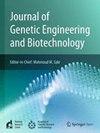Metagenomic analysis reveals diverse microbial community and potential functional roles in Baner rivulet, India
IF 3.5
Q3 Biochemistry, Genetics and Molecular Biology
Journal of Genetic Engineering and Biotechnology
Pub Date : 2023-12-01
DOI:10.1186/s43141-023-00601-x
引用次数: 0
Abstract
Background
The health index of any population is directly correlated with the water quality, which in turn depends upon physicochemical characteristics and the microbiome of that aquatic source. For maintaining the water quality, knowledge of microbial diversity is a must. The present investigation attempts to evaluate the microflora of Baner. Metagenomics has been proven to be the technique for examining the genetic diversity of unculturable microbiota without using traditional culturing techniques. The microbial profile of Baner is analyzed using metagenomics for the first time to the best of our knowledge.
Results
To explore the microbial diversity of Baner, metagenomics analysis from 3 different sites was done. Data analysis identified 29 phyla, 62 classes, 131 orders, 268 families, and 741 genera. Proteobacteria was found to be the most abundant phylum in all the sampling sites, with the highest abundance at S3 sampling site (94%). Bacteroidetes phylum was found to be second abundant in S1 and S2 site, whereas Actinobacteria was second dominant in sampling site S3. Enterobacteriaceae family was dominant in site S1, whereas Comamonadaceae and Pseudomonadaceae was abundant in sites S2 and S3 respectively. The Baner possesses an abundant bacterial profile that holds great promise for developing bioremediation tactics against a variety of harmful substances.
Conclusion
Baner river’s metagenomic analysis offers the first insight into the microbial profile of this hilly stream. Proteobacteria was found to be the most abundant phylum in all the sampling sites indicating anthropogenic interference and sewage contamination. The highest abundance of proteobacteria at S3 reveals it to be the most polluted site, as it is the last sampling site downstream of the area under investigation, and falls after crossing the main city, so more human intervention and pollution were observed. Despite some pathogens, a rich profile of bacteria involved in bioremediation, xenobiotic degradation, and beneficial fish probiotics was observed, reflecting their potential applications for improving water quality and establishing a healthy aquaculture and fishery section.
宏基因组分析揭示了印度巴纳河不同的微生物群落和潜在的功能作用。
背景:任何人群的健康指数都与水质直接相关,而水质又取决于该水源地的理化特性和微生物群。为了维持水质,微生物多样性的知识是必须的。本研究试图对banner的微生物区系进行评价。宏基因组学已被证明是一种在不使用传统培养技术的情况下检测不可培养微生物群遗传多样性的技术。据我们所知,首次使用宏基因组学分析了Baner的微生物剖面。结果:对3个不同位点进行宏基因组学分析,探索巴纳菌的微生物多样性。数据分析鉴定出29门,62纲,131目,268科,741属。变形菌门是所有采样点丰度最高的门,其中S3采样点丰度最高(94%)。S1和S2取样点拟杆菌门次之,S3取样点放线菌门次之。S1位点以肠杆菌科为主,S2和S3位点分别有大量的Comamonadaceae和Pseudomonadaceae。banner具有丰富的细菌特征,为开发针对各种有害物质的生物修复策略提供了巨大的希望。结论:巴纳河的宏基因组分析提供了对这条丘陵溪流微生物剖面的第一次洞察。变形菌门是所有采样点中数量最多的门,表明人为干扰和污水污染。S3的proteobacteria丰度最高,是调查区域下游最后一个采样点,经过主城区后下降,是污染最严重的采样点,因此存在较多的人为干预和污染。尽管存在一些病原体,但仍观察到丰富的细菌参与生物修复,外源生物降解和有益的鱼类益生菌,反映了它们在改善水质和建立健康的水产养殖和渔业部门方面的潜在应用。
本文章由计算机程序翻译,如有差异,请以英文原文为准。
求助全文
约1分钟内获得全文
求助全文
来源期刊

Journal of Genetic Engineering and Biotechnology
Biochemistry, Genetics and Molecular Biology-Biotechnology
CiteScore
5.70
自引率
5.70%
发文量
159
审稿时长
16 weeks
期刊介绍:
Journal of genetic engineering and biotechnology is devoted to rapid publication of full-length research papers that leads to significant contribution in advancing knowledge in genetic engineering and biotechnology and provide novel perspectives in this research area. JGEB includes all major themes related to genetic engineering and recombinant DNA. The area of interest of JGEB includes but not restricted to: •Plant genetics •Animal genetics •Bacterial enzymes •Agricultural Biotechnology, •Biochemistry, •Biophysics, •Bioinformatics, •Environmental Biotechnology, •Industrial Biotechnology, •Microbial biotechnology, •Medical Biotechnology, •Bioenergy, Biosafety, •Biosecurity, •Bioethics, •GMOS, •Genomic, •Proteomic JGEB accepts
 求助内容:
求助内容: 应助结果提醒方式:
应助结果提醒方式:


